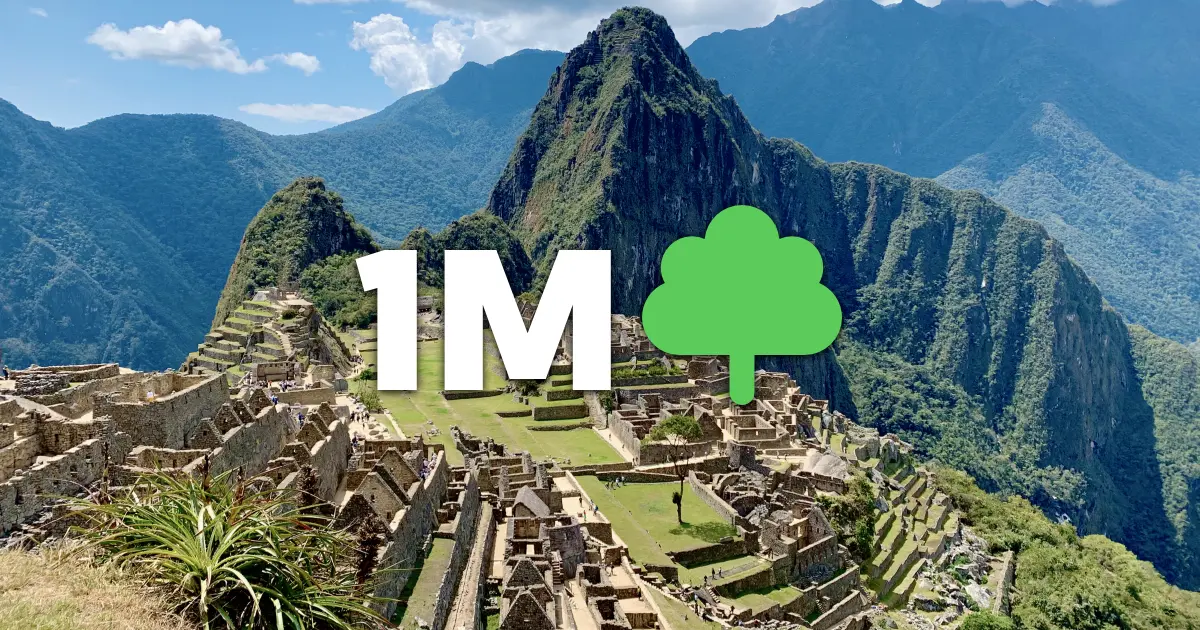
Blog / Is Machu Picchu condemned?
“One million trees for Machu Picchu and its buffer zone” is Peru’s challenge for 2020 to try to save “the old mountain”, the translation of the Quechua name “Machu Picchu”.
This ancient Inca city, dating from the 15th century, is located in the Peruvian Andes, 80km from Cuzco, nestled between the Huayna Picchu (“young mountain”) and Machu Picchu, at an altitude of 2,438 metres. Below, flows the Vilcanota-Urubamba River. The Amazonian forest begins not far from there. It is therefore both a biological and cultural jewel case, classified as World Heritage of Humanity by UNESCO and a historical sanctuary within the National Service of Natural Areas Protected by the State (SERNANP1).
This spectacular site of more than 37,000 hectares is nevertheless threatened by several factors, including mass tourism and deforestation. More than 1.5 million tourists visit the Inca ruins each year. Faced with the risk of having the archaeological complex added to the “List of World Heritage in Danger”2 by UNESCO, the Peruvian government has already taken a number of measures, which have been modified and adapted as they have been put into practice.
Initially, and following a study carried out between 2002 and 2005, a carrying capacity was calculated, which set the maximum number of tourists allowed per day at 2,500. Once this figure was reached, the site was closed to visitors. Much criticised, the regulation was modified in January 2019, after a new study carried out in 2015: from now on, it is no longer a question of “carrying capacity”, but of “reasonable maximum simultaneity “. Concretely, it is a question of regulating entries throughout the day, so that there are never more than 2,500 people on the site at the same time, and never more than 5,600 visitors in total over a day. Visits are thus divided into three time slots and, once the maximum number of online bookings has been reached, it is no longer possible to obtain an entrance. In addition, the maximum visiting time for the site has been set at four hours.
But regulating access to the archaeological site is not the only measure taken by the authorities. Another is a vast reforestation programme to combat recurrent flooding and landslide problems, particularly during the rainy season, and fires during the dry season. The “One million trees for Machu Picchu and its buffer zone” initiative aims to reforest 11,000 hectares, or 29.23% of the natural protected area, in nine sectors of the sanctuary and its buffer zone by 2022. SERNANP also highlights the benefits of this reforestation for climate change adaptation and carbon capture. The project brings together public institutions, NGOs, as well as the private sector, including tourism operators, who obviously have interests in the area. In January, the first seedlings were planted: they are exclusively native species, Andean or Amazonian depending on the sector, and the emphasis is on reforestation of the riverbanks.
It is clear that none of the parties involved in this ambitious reforestation project is acting exclusively for the good of humanity and the defence of the environment, but is defending its economic interests above all: tourists, both nationals and foreigners, boost the local and national economy, and banning access to the sanctuary would have serious consequences at all levels. However, if reforestation is carried out successfully, the objective of restoring the ecosystem will have been achieved, whether this objective is seen as primary or secondary according to the stakeholders, which is worth applauding.
More problematic is the simultaneous decision of the Peruvian government to start the construction of an airport between the city of Cuzco and the archaeological site, in order to provide travellers with easier access to the Inca site. An airport capable of welcoming 6 to 8 million travellers per year…far, therefore, from the maximum 5600 visitors allowed per day. And it is highly likely that other infrastructures will be added to this one, multiplying the problems linked to the change of land use and increasing even more the urbanistic pressure on this already fragile area.
Other initiatives should also be carefully analysed, such as those proposed by some travel agencies, inviting travellers to subscribe to their services in exchange for a planted tree. Has it really been established that the damage caused during visits is compensated for by the benefits of planting a tree, or is this no more and no less than a fallacious argument? Time will tell.
-
Servicio Nacional de Áreas Naturales Protegidas por el Estado ↩
-
“Inscription of a site on the List of World Heritage in Danger enables the Committee to grant immediate assistance under the World Heritage Fund. (…) Inscription on the List of World Heritage in Danger is not perceived in the same way by all parties concerned. Some countries request the inscription of a site to focus international attention on its problems and to obtain competent assistance to solve them. Others, however, wish to avoid a listing that they perceive as a dishonour.” See https://whc.unesco.org/fr/158/. ↩

Yasmina is a geographer. Her travels started when she was very young, through books. It continued when she discovered geograhy in class and then with a bag on her back.